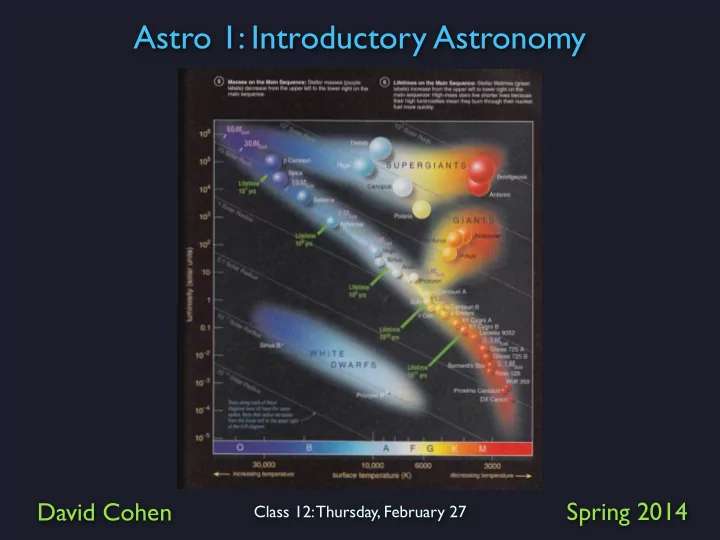

Astro 1: Introductory Astronomy David Cohen Spring 2014 Class 12: Thursday, February 27
stellar spectra: as a function of temperature
Table 15.1: the basis of the spectral type sequence, the empirical temperature scale of stars
Where are these stars on the HR diagram? ...it depends on knowing their distances (why?) http://apod.nasa.gov/apod/ap081015.html
The following slides show the events in a low-mass star’s life
large cloud of interstellar gas and dust - giving birth to millions of stars Hubble Space Telescope: Carina Nebula
http://apod.nasa.gov/apod/ap110110.html
http://apod.nasa.gov/apod/ap120605.html
http://apod.nasa.gov/apod/ap130829.html
http://apod.nasa.gov/apod/ap130605.html
http://apod.nasa.gov/apod/ap130409.html
http://apod.nasa.gov/apod/ap120826.html
large cloud of interstellar gas and dust - giving birth to millions of stars: the brightest stars are the most massive stars Hubble Space Telescope: Carina Nebula
all the most luminous stars are massive http://apod.nasa.gov/apod/ap081015.html
strong stellar wind ejects much of the massive star’s surface into space before its death http://apod.nasa.gov/apod/ap120816.html
Crab nebula: a 1000 year old supernova remnant http://apod.nasa.gov/apod/ap111225.html
reactions that go down the curve produce energy - iron is the end of the line for nuclear energy production
the amounts (or “abundances”) of each element - strong evidence that we understand how elements are produced, primarily in massive stars
We didn’t get to the following in class, but you’ve read about it, and we’ve touched on the physics: main sequence lifetimes of stars are directly related to their luminosities and masses (with luminosities dominating: high luminosity stars use up their fuel quickly and have short lives) We can use this fact to figure out how old star clusters are
http://apod.nasa.gov/apod/ap130501.html
the following slides show a star orbiting in a binary system and ask you some questions about its Doppler shift (and eventually, about its companion and their masses) - see if you can answer them
At which position (1, 2, 3, or 4) does the star have the biggest blueshift?
At which position (1, 2, 3, or 4) does the star have the no Doppler shift?
what about the other star in the binary system? See the next slide. the “x” is the center of mass of the system
What position for the blue star does the red star’s position correspond to? 1, 2, 3, or 4?
What is the mass of the red star relative to the blue star (roughly)?
The same spectroscopic binary , on two successive nights
Recommend
More recommend